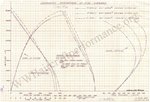wuzak
Captain
1. P-40B: top speed 352 mph on 1,040 HP (1710-33), climb rate 14.5 m/s initial.
2. P-40E: top speed 360 mph on 1,150 HO (1710-39), climb rate 10.7 m/s initial.
3. P-40F: top speed 364 mph on 1,300 HP (1650-1), climb rate averaged 83.8 m/s to 6,100 m (wish they gave initial climb rate!)
4. P-40N: top speed 378 mph in 1,200 HP (1710-81), climb rate 11.4 m/s initial.
Wow..the P-40F had a climb rate 8 times that of the P-40E!
Since the 1650-1 was a single-stage Merlin, what difference was expected?
The -1 was a single stage 2 speed Merlin. It had the improved supercharger of the Merlin XX, so its performance would theorteically be moved higher in altitude. Because ofthe 2 speed supercharger the loss of performance at lower altitudes would have been minimised.
If they had used a 2-stage, multi-speed Merlin .... maybe it would have been interesting. Of course, then, to be fair, they'd have to fit an Allison with a competitive system (aux stage or turbo). That might have needed a different airframe ...
Certainly a turbo system or the Allison 2 stage system would have required a lot of work on the P-40 airframe. The 2 stage Merlin was not much longer than the original Allison, but quite a bit heavier. Some weights would have to have been readjusted, and extra cooling would have been required.
I see that some of this has been commented on by others but, really, the Merlin-powered P-40F was no better than the Allison-powered one, unless a 2,000 foot ceiling difference was being deemed important. I doubt seriously that anyone wanted to fight a P-40 at 30,000+ feet anyway. the real question of interest would be a comparison at 10,000 - 15,000 feet, where it was employed in combat.
It would appear that the P-40F had roughly the same performance as the E at the E's best altitude, but the F's best altitude was about 8000ft higher. (P-40E 342mph @ 11,400ft, 340mph @ 15,300, P-40F 350.5mph @ 12,800ft, 364.5mph @ 19,270ft).
http://www.wwiiaircraftperformance.org/P-40/P-40E_40-384_PHQ-M-19-1300-A.pdf
http://www.wwiiaircraftperformance.org/P-40/P-40F_41-13601_PHQ-M-19-1440-A.pdf
P-40 Performance Tests
Since they installed a single stage Merlin, I'm pretty sure nobody expected it to be better by any significant amount. Maybe that was the point of the exercise ... to demonstrate the equivalence of the two installations. That it certainly did.
The point of the exercise was to use the V-1650-1s that the USAAF were getting under the terms of the Packard agreement (1/3 of Packard production was to go the the USAAF).

